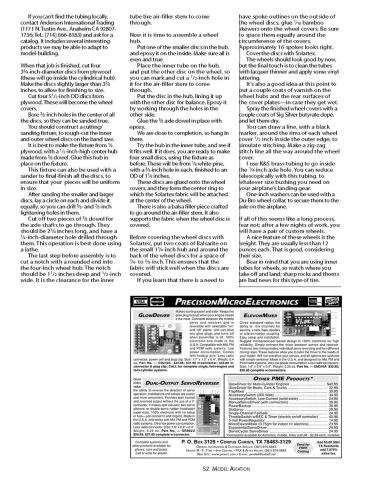Balloon
Large Models
Wheels
for
any times, those who build large
models run into the problem of not
being able to purchase wheels that
are large enough for their airplanes. When
the builder decides to make a 1⁄4- or 1⁄3-scale
airplane, he or she will probably find
nothing commercially available.
Faced with this problem a few years ago, I
thought it might be possible to make some
wheels similar to the Trexler “balloon” variety
that have been popular throughout the years.
I decided to see what I could make in an
8- to 91/2-inch-diameter wheel-and-tire
arrangement, using industrial- and
wheelbarrow-size inner tubes.
January 2001 49
n Lawrence Klingberg
This is how the inner tube looks before it becomes a custom
Giant model tire. Note the fitted inner plywood ring.
A specially constructed fixture is used to accurately and safely
saw the four-inch plywood cylinder stock to make the hub.
The tire on the left is eight inches in diameter and has simulated stitching. The tire on
the right is 91⁄2 inches in diameter and features simulated spokes.
Skip the
wheel search and
“roll” your own
M
skewers onto the wheel covers. Be
sure to space them equally around the
circumference of the covers.
Approximately 16 spokes looks right.
Cover the discs with Solartex.
The wheels should look good by now,
but the final touch is to clean the tubes
with lacquer thinner and apply some
vinyl lettering.
It’s also a good idea at this point to
put a couple coats of varnish on the
wheel hubs and the rear surfaces of
the cover plates—in case they get wet.
Spray the finished wheel covers with
a couple coats of Sig Silver butyrate
dope, and let them dry.
You can draw a line, with a black
marker, around the rims of each wheel
cover 1/2 inch inside the outer edge, to
simulate stitching. Make a zig-zag
stitch line all the way around the
wheel cover.
I use K&S brass tubing to go
inside the 1⁄4-inch axle hole. You can
reduce telescopically with this tubing,
to whatever size bushing you need on
your airplane’s landing gear.
One-inch washers can be used with a
Du-Bro wheel collar, to secure them to
the axle on the airplane.
if all of this seems like a long
process, fear not; after a few nights of
work, you will have a pair of custom
wheels.
A nice feature of these wheels is the
weight. They are usually less than 12
ounces each. That is good, considering
their size.
Bear in mind that you are using
inner tubes for wheels, so watch where
you take off and land; sharp rocks and
thorns are bad news for this type of tire.
They are low-pressure tires, and they
should be inflated only enough to make
them firm. Do not overinflate them!
Parts List:
One piece of 1⁄8 plywood sheet stock, 3 x 3
feet
One 5⁄8 wood dowel, 12 inches long
Two eight-inch-diameter industrial
wheels and/or wheel barrow inner tubes
purchased from Northern Tool and
Equipment Co. (For a free catalog, write
to Box 1499 Burnsville MN 55337 or
call [800] 533-5545.)
One sheet of Presto vinyl letters (white)
One piece of four-inch OD plywood laminatedcore
tubing with a 1⁄8 wall or the same size
heavy-duty mailing tube, 12 inches long
1⁄4-roll Olive Drab Solartex, or a portion
thereof
One can of Sig Silver butyrate spray dope
One can of five-minute epoxy
Scrap balsa and white pine pieces
Miscellaneous pieces of K&S brass
tubing
Happy landings and keep ’em flying. MA
Lawrence Klingberg
8111 Dartmoor Dr.
Huntington Beach CA 92646







